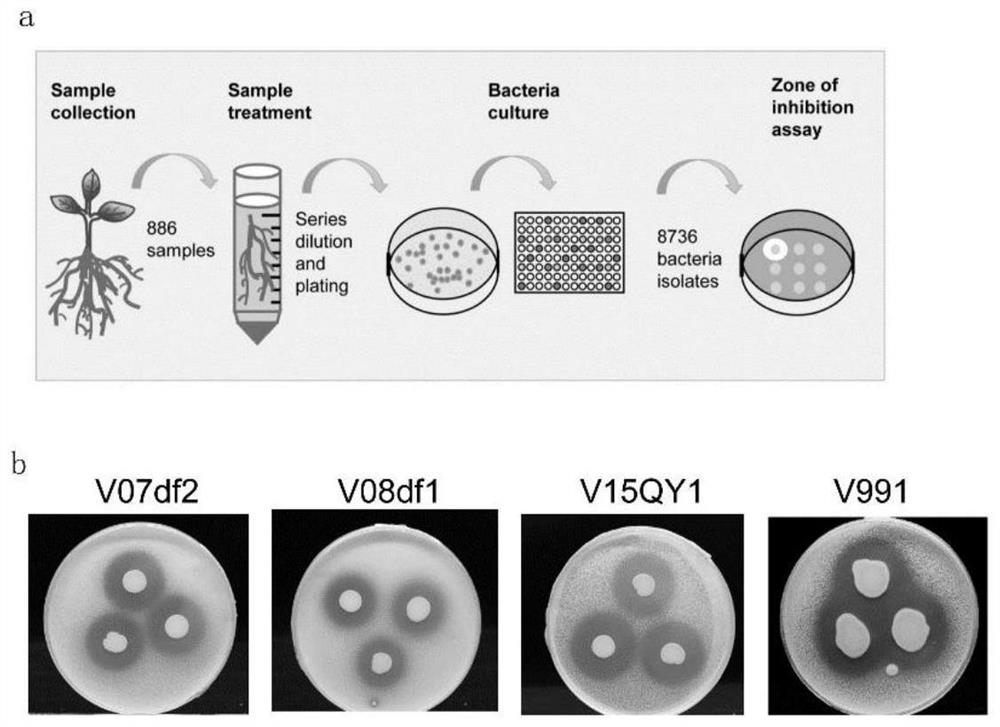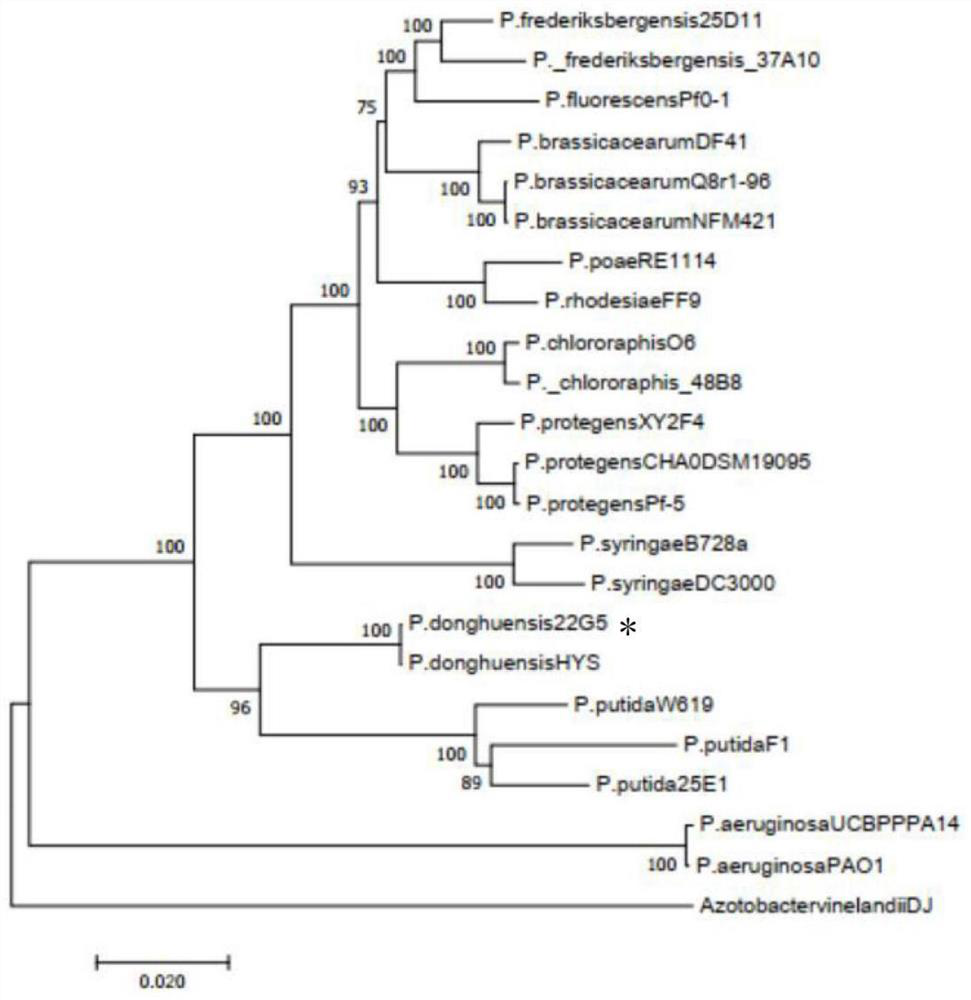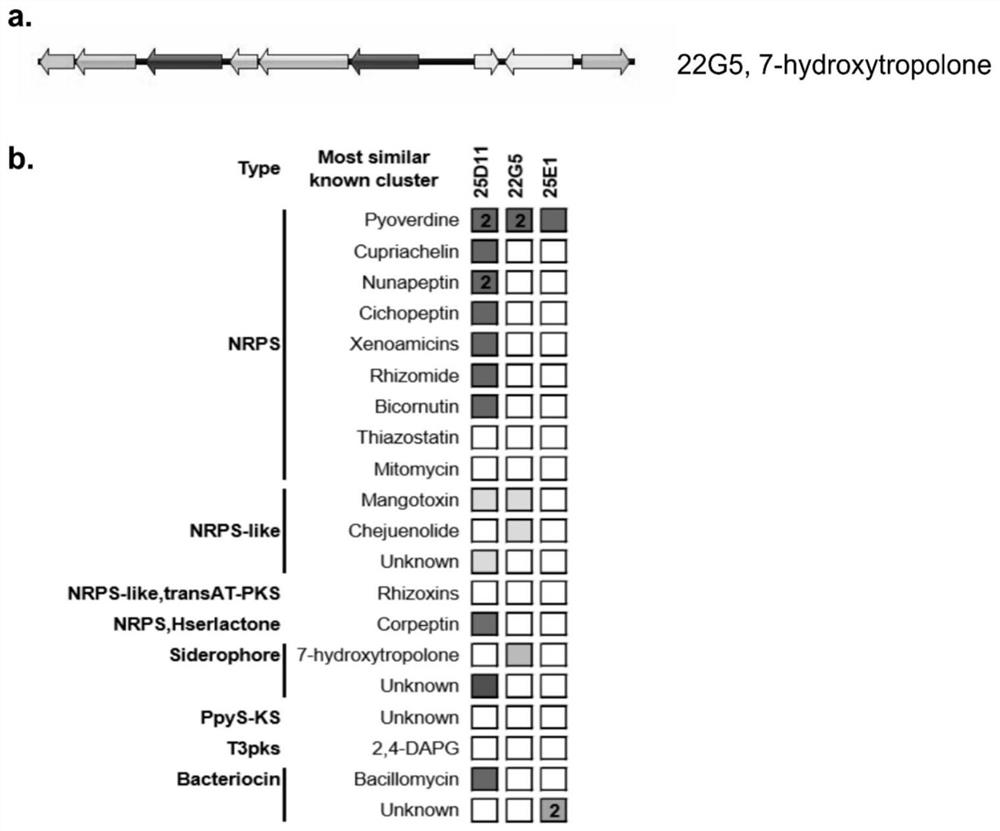Application of 7-hydroxytropolone in preventing and treating verticillium wilt of crops
A technology for hydroxycycloheptatrienolone and verticillium wilt, which is applied in the application field of 7-hydroxycycloheptatrienolone in preventing and treating crop verticillium wilt, can solve problems such as limited strains and products, and reduce the incidence of disease rate, significant inhibitory effect, and the effect of reducing the occurrence of Verticillium wilt
- Summary
- Abstract
- Description
- Claims
- Application Information
AI Technical Summary
Problems solved by technology
Method used
Image
Examples
Embodiment 1
[0035] Isolation and screening of embodiment 1 Pseudomonas 22G5
[0036] The experimental procedures for large-scale screening of Verticillium wilt antagonistic strains are attached figure 1 as shown in a:
[0037] 1. Sample Collection
[0038] Samples were collected from Anhui, Zhejiang, Jiangsu, Xinjiang, Jilin, Heilongjiang, Hunan, Shanghai and other places. Weeds, corn, cotton, Soiled root samples of various plants such as soybeans. The root samples with soil were isolated by dilution coating plate method. Select samples of soil, root system, etc. and place them in 50ml collection tubes, add 45ml of water to mix and shake, generally carry out 4 to 5 times of shaking, absorb 800μl of the mixed solution, and use ddH 2 O Perform 10 on a 96-well plate 1 -10 5 gradient dilution. Select 10 μl solution of appropriate concentration to spread on LB medium, generally choose 10 μl 3or 10 4 The diluted concentration of the plate was spread on the plate, and the plate was cult...
Embodiment 2
[0041] Example 2 Identification and genome sequencing of Pseudomonas fluorescens 22G5
[0042] 1. Morphological identification
[0043] Strain 22G5 is Gram-negative, non-spore-forming, and provides motility with single or multiple flagella. After being cultured on LB medium for 24 hours, large colonies can be formed. The colonies do not produce pigment, and the surface is raised, smooth, viscous and easy to provoke.
[0044] 2. Molecular identification
[0045] In order to clarify the strain classification of the bacterial strain 22G5 obtained in Example 1, we analyzed the 16S ribose DNA (rDNA) sequence of the bacterial strain 22G5 for the molecular biology identification of bacteria. The homology of the bacterial model strain Pseudomonas donghuensis HYS (T) strain reaches the highest 99%, indicating that the strain belongs to Pseudomonas donghuensis species. Pseudomonas is a class of Gram-negative bacteria containing multiple species. Due to their diversity in morphologica...
Embodiment 3
[0050] The mensuration of embodiment 3 Pseudomonas 22G5 antibacterial activity
[0051] In order to better study the biocontrol potential of the bacterial strain 22G5 of the present invention, we studied the bacteriostatic spectrum of the bacterium.
[0052] The specific operation is as follows:
[0053] Zone of inhibition test
[0054] In order to explore whether 22G5 has broad-spectrum resistance to multiple strong pathogenic strains of Verticillium dahliae, use the same method as in Example 1 for strain screening, and replace the pathogenic bacteria V15QY1 with the same amount of culture conditions and methods. Multiple strong pathogenic strains of V07df2, V08df1 and V991, the rest of the steps remain unchanged. Experimental results found that strain 22G5 also had a strong antibacterial effect on Verticillium dahliae V07df2, V08df1 and V991 ( figure 1 a).
PUM
 Login to View More
Login to View More Abstract
Description
Claims
Application Information
 Login to View More
Login to View More - R&D
- Intellectual Property
- Life Sciences
- Materials
- Tech Scout
- Unparalleled Data Quality
- Higher Quality Content
- 60% Fewer Hallucinations
Browse by: Latest US Patents, China's latest patents, Technical Efficacy Thesaurus, Application Domain, Technology Topic, Popular Technical Reports.
© 2025 PatSnap. All rights reserved.Legal|Privacy policy|Modern Slavery Act Transparency Statement|Sitemap|About US| Contact US: help@patsnap.com



